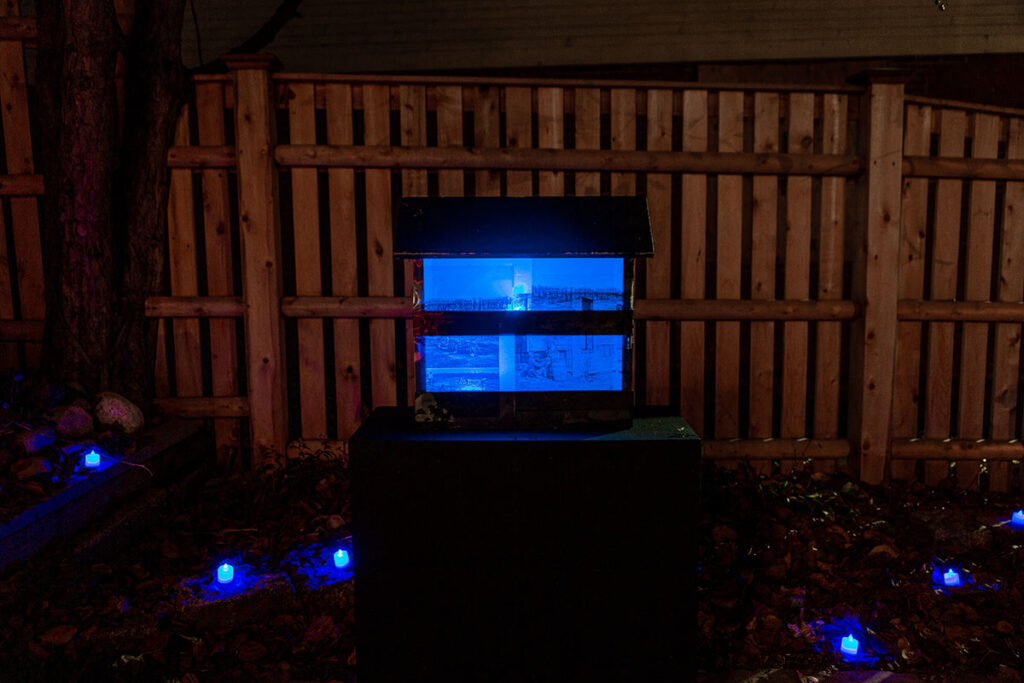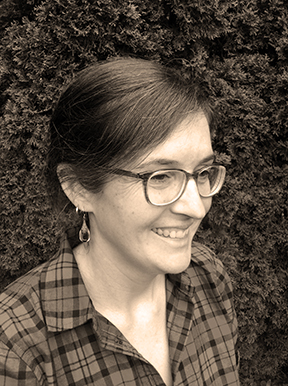by Hilary Irons
Walking into artist and writer Asata Radcliffe’s studio this past August, at Rockland’s Ellis-Beauregard Foundation, one has the impression of walking into the first chapter of a complex mystery novel. Some of the elements on view hold immediate meaning, some hold a complex set of meanings, and some defy understanding until addressed by the Detective. The Detective in this case, Radcliffe herself, moves through the material with the precision required when reconstructing a many-layered dream. The result of her attention and focus is a slow unfolding; a sense of inevitability overlaid with the surreal, in a space that is both transitory and ancient.
The studio is big and airy, and very quiet. It is one of the classrooms in a late 19th-century Midcoast Maine schoolhouse, with tall windows, a chalkboard wall, and a sense of expectation. The objects and artworks gaze back at the visitor, with a kind of silent question. “What is your intention;” the artwork seems to ask, “what are you bringing to this place?” Uneven rectangles of transparent plastic sheeting hang from the walls; the floors are covered with more sheets of plastic, marked with blue paint. Black-and-white photographs of WWII-era African American men in long coats inhabit the space here and there, joined by a forbidding mannequin head with a pink hat, standing on a kind of elevated chessboard. A strangely formal, symmetrical arrangement of intricate collages — bracketed by ceremonial-looking curtains — dominates the largest wall. From inside the collages gaze the faces of humans and demigods, ferocious and full of movement. The mystery-novel quality of the room reveals itself to have other facets, both spiritual and science-fictional.
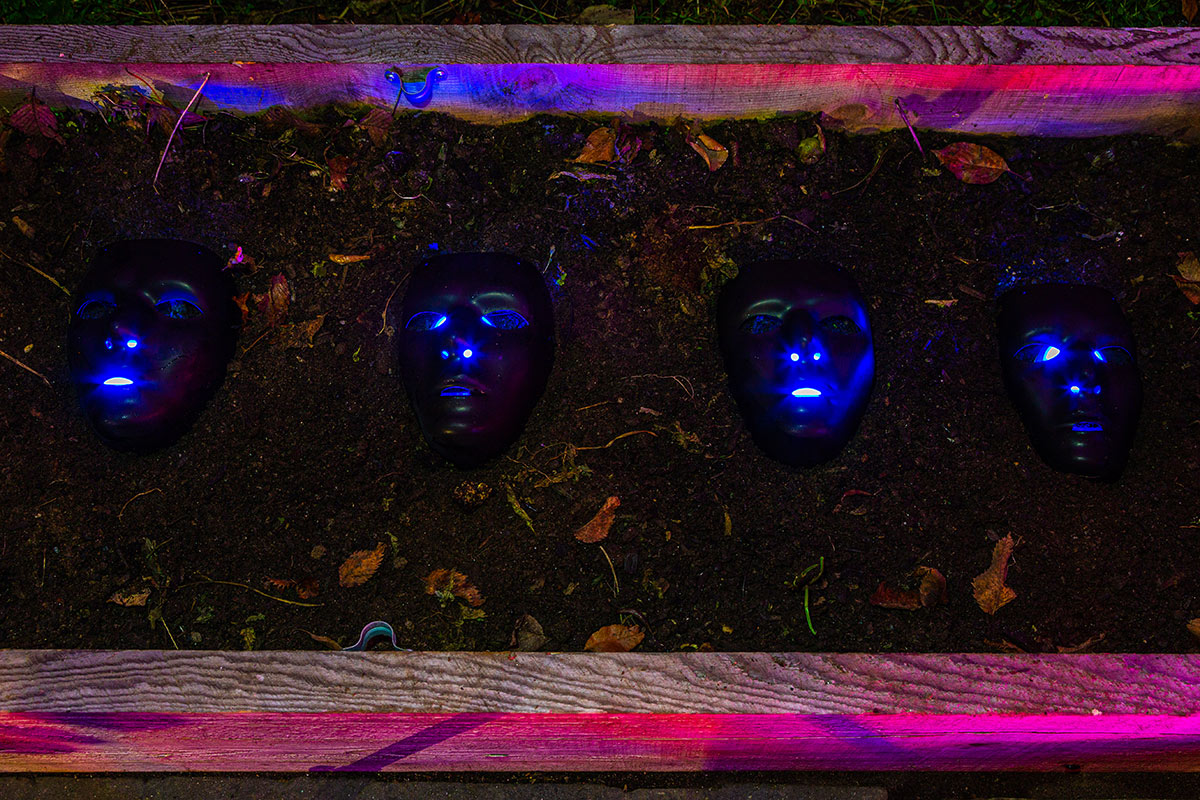
“Futurism runs all through my practice,” Radcliffe says. “My interests, at the moment, include a fusion of ancient culture and a futurist vision. I ask how I can place myself in a spiritual practice that is beneficial within the time I exist.” Buddhism and the practice of Dharma have operated as an anchoring interest for Asata over the past twelve years, and the Buddhist inclination to simultaneously accept the unknown and embrace contradictions influences her approach to artmaking. An artist of both Black and Indigenous heritage, she asks: “As a descendant of people who were enslaved, and subjected to genocide, a mass attempt to annihilate two cultures of people, how do I envision and enact the evolution of spirituality? Meditation is no longer just a practice from ‘the East’.” For Asata, the Hindi word Kal — meaning both “yesterday” and “tomorrow” — holds part of the key to this advancement of understanding. She was introduced to the understanding of this word via artist and textile designer Meeta Mastani.1 “Dharma is key to me staying grounded as my vision has never been in the present moment,” Asata asserts. “Merging the spiritual and art becomes a way to deal with experience — especially the experience of societal trauma.”
Before embracing a primarily visual arts-based practice, Radcliffe worked as a writer, filmmaker, and educator. She retains an academic’s intellectual excitement around research and installation, and her studio functions as both a laboratory and an archive. “Usually my practice starts with research,” she says. “One of the classes I teach is based in diverse Eco-literature, and this necessarily involves the question of how we engage with and take care of the planet.”
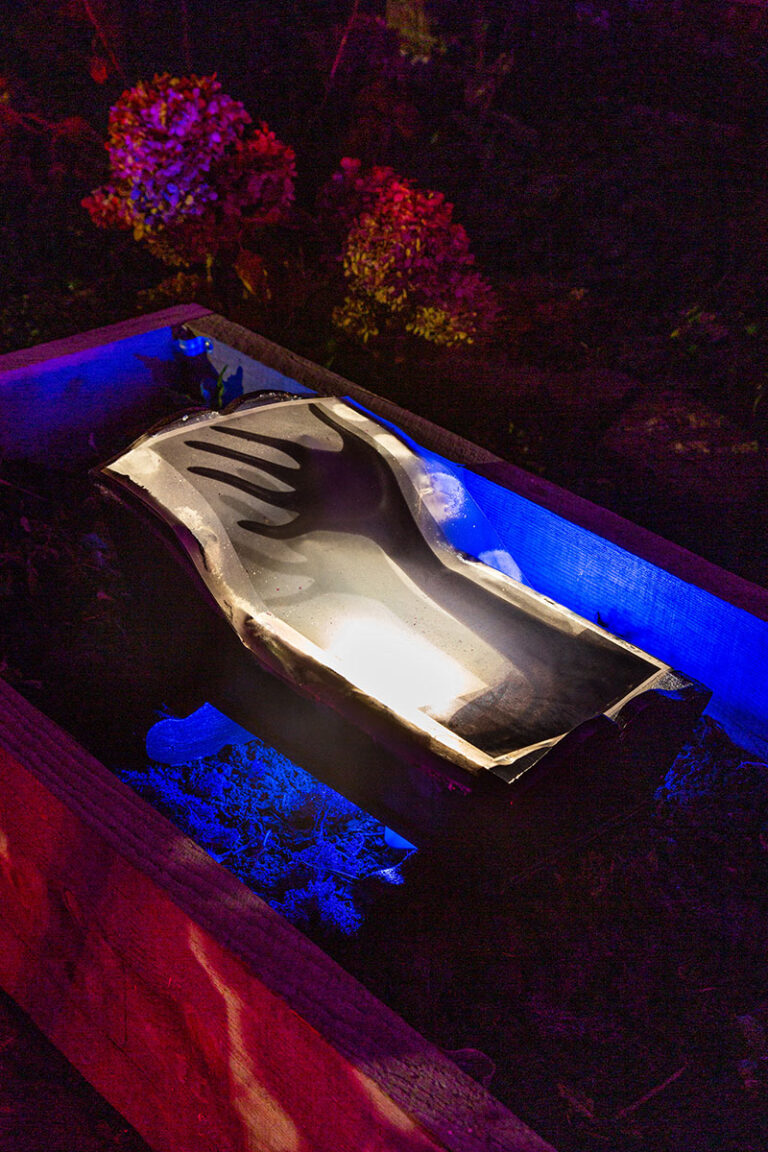
Radcliffe’s research interests are far-ranging — becoming an expert on the history of the Black Guard soldiers in Maine; investigating the pantheon of Tibetan Buddhist dharmapalas; collecting and repatriating racist curios from local antique shops; re-contextualizing the concept of the Anthropocene as experienced by a Black woman in America in the 21st century. “I recently read an article in Emergence Magazine, “When You Meet the Monster, Anoint Its Feet,” by Bayo Akomolafe. The article talks about confronting the idea of the Anthropocene, and how this era is entrenched in white supremacy. Human beings have become commodified and left with no sense of freedom. The intellect is cut off; the limbs don’t function for self-liberation, as demonstrated in some of my work. Human beings, people of color, don’t have a lot of agency over how we wish to protect the land.” The environment and its fate play a large role in the unfolding narrative of Radcliffe’s work, and Akomolafe’s article helps situate one’s sense of historical experience of the environment. “White male scientists created the names of the geological eras we live in, the Holocene, the Anthropocene… This filters down through all levels of education. The idea of the ‘Anthropocene’ acts as an official directive, a defining of what this age signifies for human beings. As a concept, it is ultimately politicized, and society fulfills the demands of this narrative that has been pre-defined for us. Thinkers like Akomolafe are digging deep to deconstruct this narrative.”
Echoes of this overarching concern for land ethics run through all of Radcliffe’s work. Narratives of enveloping water and sky grow from the contrary material of polluting physical objects, like sheets of plastic, screens, spray paint, and blue electric lights. The plastic and screens hang at various angles, resisting our desire for horizontal and vertical precision. “I want to unsquare the space,” she says. “The shape of a square, a square canvas, square walls, within the art space, for me, leaves me feeling cornered, like I must create within the confines handed to me. And plastic is a counterintuitive material. The performance of the work on plastic holds the energy of being disembodied in this realm. In terms of things that are destructive, plastic is the worst. When I go into a hardware store and see them selling it — I want to use it as a justification. Plastic isn’t the enemy. I’m repatriating it, not polluting with the material. Transparent material we see through. It’s a confrontation for me. This exploration is a way of me projecting my experience in the physical realm.”
As a Detective — a Private Eye — in the realm of the spirit, the environment, and history, Asata Radcliffe is feeling her way through a complexity of understanding that can fully unfold only by embracing material and process as a co-author of her work. “I can start with the cerebral, but process always takes over. I work through ideas — like variations on the color blue — and finally know I’m looking for something specific. A certain pattern. I am figuring out the material, and the goal is to reinvent the experience of space.”
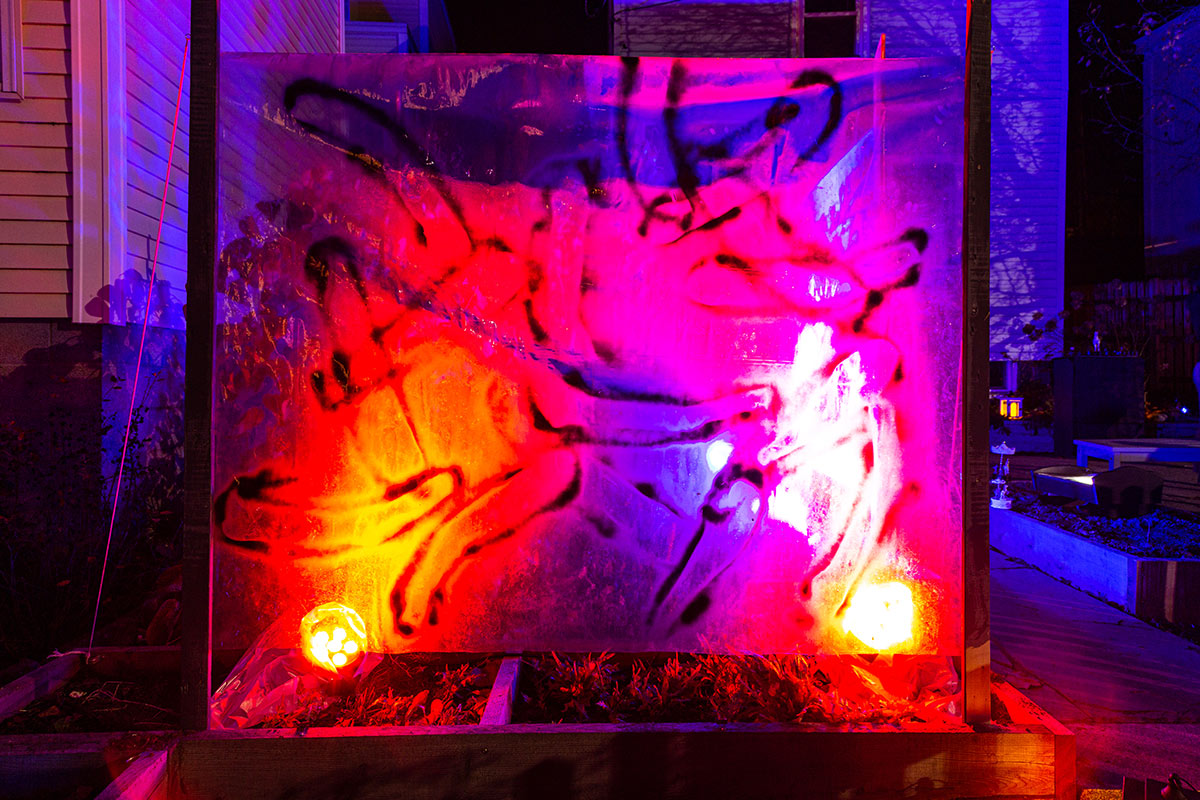
Asata Radcliffe is a writer and multimedia artist. A California native, Asata received her MFA in Creative Writing (Fiction) from Antioch University in Los Angeles. She writes speculative fiction and essays. Her creative work culminates as multimedia collections of speculative art installation, merging writing, film, and form. Her work invites one to experience the interstitial spaces of speculative landscapes and surrealist futures. Concerned about the planet, her research includes topics of land ethics, futurism, and the nonlinear narratives of human existence.
Asata’s curatorial project, A Convenient Soldier: The Black Guards of Maine, is currently on view at the Maine Historical Society in Portland, Maine. She was recently in residence at SPACE, with whom she was also a participating artist in Re-Site, a site-specific public art and Portland history-telling initiative featuring Asata’s installation, A Slower Ontology, along with work by Asha Tamirisa, Shane C. Smith, Veronica A. Perez, and Heather Flor Cron.
- Editor’s note: Radcliffe and Mastani were both in residence at Indigo Arts Alliance, in Portland, Maine, in the Fall of 2019. ↩
Hilary Irons is an artist and curator who lives in Portland, Maine. She received an MFA from the Yale School of Art in 2008, and a BFA from Parsons School of Design in 2002. Residencies have included the American Academy in Rome, MacDowell, Hewnoaks, and Canterbury Shaker Village.

